Cultural Analysis: Issues in International Business - USA & Singapore
VerifiedAdded on 2023/06/14
|13
|3318
|338
Report
AI Summary
This report provides a cultural analysis of the United States of America in the context of international business, comparing it with Singapore. It uses Hofstede's cultural dimensions to highlight differences in power distance, individualism, masculinity, uncertainty avoidance, long-term orientation, and indulgence. The report identifies unique components of American culture, such as observable artifacts, enacted values, and espoused values, and discusses their impact on business practices. It also explores the business culture of the United States, characterized by competitiveness, efficiency, informality, individualism, and openness to change. The analysis contrasts the American business culture with that of Singapore, emphasizing the importance of social hierarchy and manners in Singaporean business. The report concludes by highlighting the factors that foreign organizations should consider when operating in the United States.
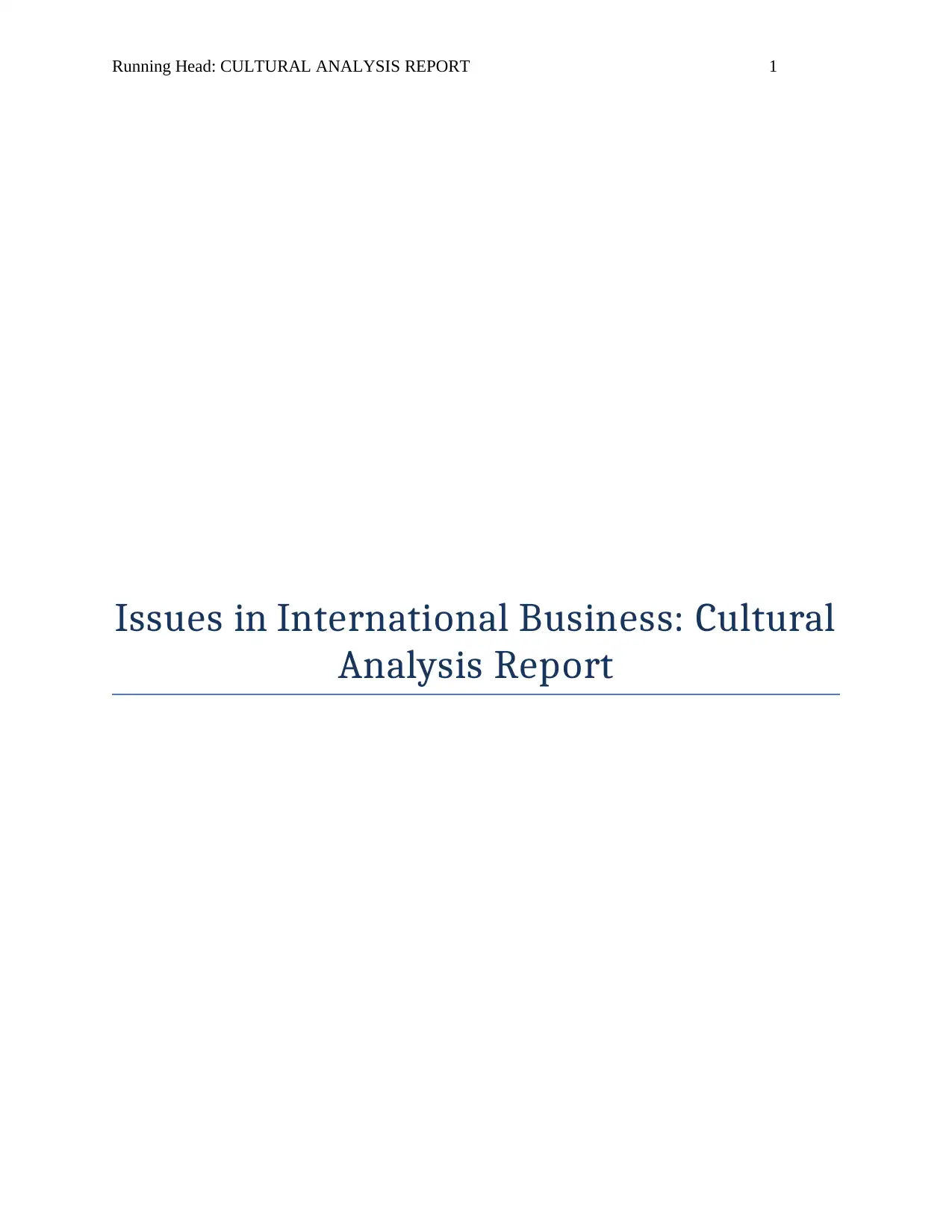
Running Head: CULTURAL ANALYSIS REPORT 1
Issues in International Business: Cultural
Analysis Report
Issues in International Business: Cultural
Analysis Report
Paraphrase This Document
Need a fresh take? Get an instant paraphrase of this document with our AI Paraphraser
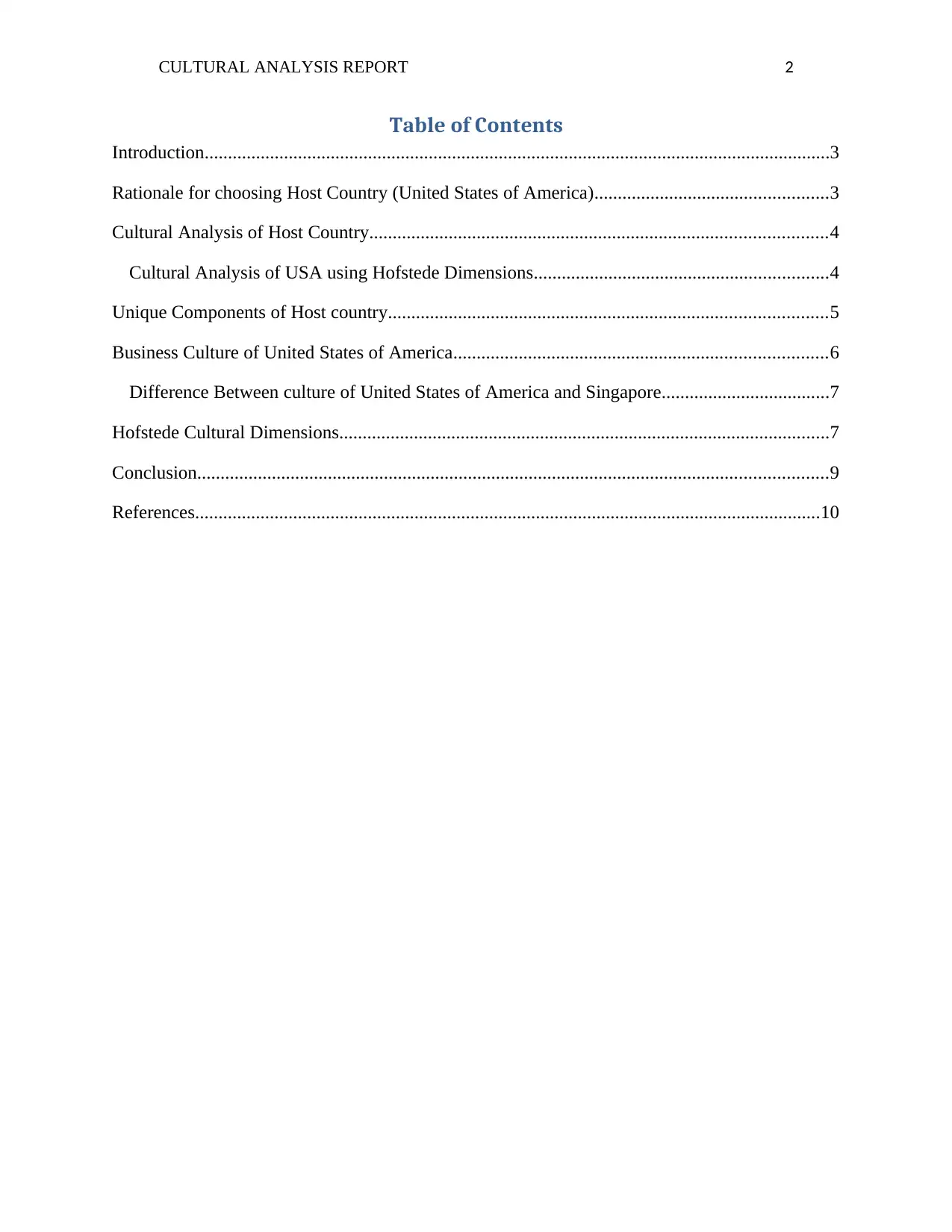
CULTURAL ANALYSIS REPORT 2
Table of Contents
Introduction......................................................................................................................................3
Rationale for choosing Host Country (United States of America)..................................................3
Cultural Analysis of Host Country..................................................................................................4
Cultural Analysis of USA using Hofstede Dimensions...............................................................4
Unique Components of Host country..............................................................................................5
Business Culture of United States of America................................................................................6
Difference Between culture of United States of America and Singapore....................................7
Hofstede Cultural Dimensions.........................................................................................................7
Conclusion.......................................................................................................................................9
References......................................................................................................................................10
Table of Contents
Introduction......................................................................................................................................3
Rationale for choosing Host Country (United States of America)..................................................3
Cultural Analysis of Host Country..................................................................................................4
Cultural Analysis of USA using Hofstede Dimensions...............................................................4
Unique Components of Host country..............................................................................................5
Business Culture of United States of America................................................................................6
Difference Between culture of United States of America and Singapore....................................7
Hofstede Cultural Dimensions.........................................................................................................7
Conclusion.......................................................................................................................................9
References......................................................................................................................................10
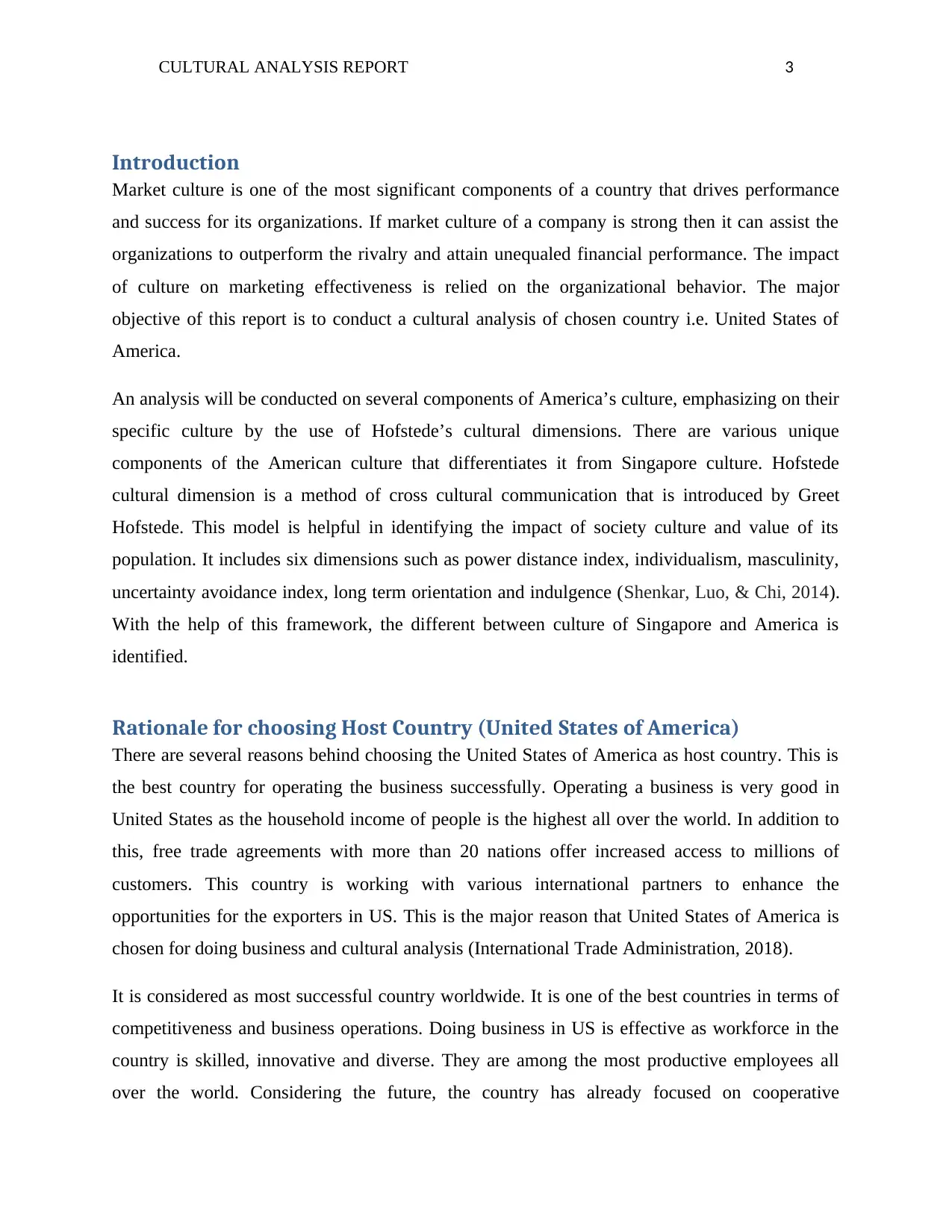
CULTURAL ANALYSIS REPORT 3
Introduction
Market culture is one of the most significant components of a country that drives performance
and success for its organizations. If market culture of a company is strong then it can assist the
organizations to outperform the rivalry and attain unequaled financial performance. The impact
of culture on marketing effectiveness is relied on the organizational behavior. The major
objective of this report is to conduct a cultural analysis of chosen country i.e. United States of
America.
An analysis will be conducted on several components of America’s culture, emphasizing on their
specific culture by the use of Hofstede’s cultural dimensions. There are various unique
components of the American culture that differentiates it from Singapore culture. Hofstede
cultural dimension is a method of cross cultural communication that is introduced by Greet
Hofstede. This model is helpful in identifying the impact of society culture and value of its
population. It includes six dimensions such as power distance index, individualism, masculinity,
uncertainty avoidance index, long term orientation and indulgence (Shenkar, Luo, & Chi, 2014).
With the help of this framework, the different between culture of Singapore and America is
identified.
Rationale for choosing Host Country (United States of America)
There are several reasons behind choosing the United States of America as host country. This is
the best country for operating the business successfully. Operating a business is very good in
United States as the household income of people is the highest all over the world. In addition to
this, free trade agreements with more than 20 nations offer increased access to millions of
customers. This country is working with various international partners to enhance the
opportunities for the exporters in US. This is the major reason that United States of America is
chosen for doing business and cultural analysis (International Trade Administration, 2018).
It is considered as most successful country worldwide. It is one of the best countries in terms of
competitiveness and business operations. Doing business in US is effective as workforce in the
country is skilled, innovative and diverse. They are among the most productive employees all
over the world. Considering the future, the country has already focused on cooperative
Introduction
Market culture is one of the most significant components of a country that drives performance
and success for its organizations. If market culture of a company is strong then it can assist the
organizations to outperform the rivalry and attain unequaled financial performance. The impact
of culture on marketing effectiveness is relied on the organizational behavior. The major
objective of this report is to conduct a cultural analysis of chosen country i.e. United States of
America.
An analysis will be conducted on several components of America’s culture, emphasizing on their
specific culture by the use of Hofstede’s cultural dimensions. There are various unique
components of the American culture that differentiates it from Singapore culture. Hofstede
cultural dimension is a method of cross cultural communication that is introduced by Greet
Hofstede. This model is helpful in identifying the impact of society culture and value of its
population. It includes six dimensions such as power distance index, individualism, masculinity,
uncertainty avoidance index, long term orientation and indulgence (Shenkar, Luo, & Chi, 2014).
With the help of this framework, the different between culture of Singapore and America is
identified.
Rationale for choosing Host Country (United States of America)
There are several reasons behind choosing the United States of America as host country. This is
the best country for operating the business successfully. Operating a business is very good in
United States as the household income of people is the highest all over the world. In addition to
this, free trade agreements with more than 20 nations offer increased access to millions of
customers. This country is working with various international partners to enhance the
opportunities for the exporters in US. This is the major reason that United States of America is
chosen for doing business and cultural analysis (International Trade Administration, 2018).
It is considered as most successful country worldwide. It is one of the best countries in terms of
competitiveness and business operations. Doing business in US is effective as workforce in the
country is skilled, innovative and diverse. They are among the most productive employees all
over the world. Considering the future, the country has already focused on cooperative
⊘ This is a preview!⊘
Do you want full access?
Subscribe today to unlock all pages.

Trusted by 1+ million students worldwide
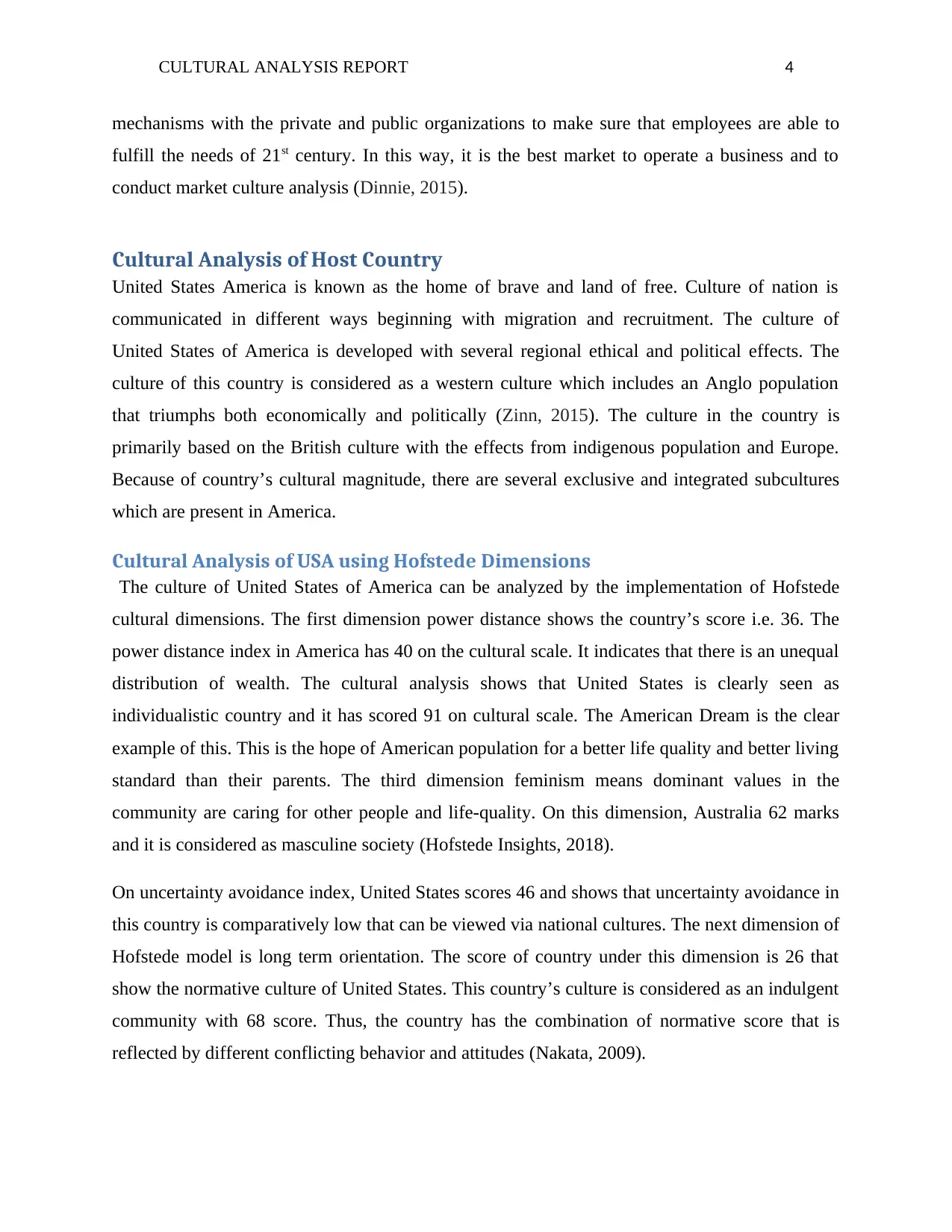
CULTURAL ANALYSIS REPORT 4
mechanisms with the private and public organizations to make sure that employees are able to
fulfill the needs of 21st century. In this way, it is the best market to operate a business and to
conduct market culture analysis (Dinnie, 2015).
Cultural Analysis of Host Country
United States America is known as the home of brave and land of free. Culture of nation is
communicated in different ways beginning with migration and recruitment. The culture of
United States of America is developed with several regional ethical and political effects. The
culture of this country is considered as a western culture which includes an Anglo population
that triumphs both economically and politically (Zinn, 2015). The culture in the country is
primarily based on the British culture with the effects from indigenous population and Europe.
Because of country’s cultural magnitude, there are several exclusive and integrated subcultures
which are present in America.
Cultural Analysis of USA using Hofstede Dimensions
The culture of United States of America can be analyzed by the implementation of Hofstede
cultural dimensions. The first dimension power distance shows the country’s score i.e. 36. The
power distance index in America has 40 on the cultural scale. It indicates that there is an unequal
distribution of wealth. The cultural analysis shows that United States is clearly seen as
individualistic country and it has scored 91 on cultural scale. The American Dream is the clear
example of this. This is the hope of American population for a better life quality and better living
standard than their parents. The third dimension feminism means dominant values in the
community are caring for other people and life-quality. On this dimension, Australia 62 marks
and it is considered as masculine society (Hofstede Insights, 2018).
On uncertainty avoidance index, United States scores 46 and shows that uncertainty avoidance in
this country is comparatively low that can be viewed via national cultures. The next dimension of
Hofstede model is long term orientation. The score of country under this dimension is 26 that
show the normative culture of United States. This country’s culture is considered as an indulgent
community with 68 score. Thus, the country has the combination of normative score that is
reflected by different conflicting behavior and attitudes (Nakata, 2009).
mechanisms with the private and public organizations to make sure that employees are able to
fulfill the needs of 21st century. In this way, it is the best market to operate a business and to
conduct market culture analysis (Dinnie, 2015).
Cultural Analysis of Host Country
United States America is known as the home of brave and land of free. Culture of nation is
communicated in different ways beginning with migration and recruitment. The culture of
United States of America is developed with several regional ethical and political effects. The
culture of this country is considered as a western culture which includes an Anglo population
that triumphs both economically and politically (Zinn, 2015). The culture in the country is
primarily based on the British culture with the effects from indigenous population and Europe.
Because of country’s cultural magnitude, there are several exclusive and integrated subcultures
which are present in America.
Cultural Analysis of USA using Hofstede Dimensions
The culture of United States of America can be analyzed by the implementation of Hofstede
cultural dimensions. The first dimension power distance shows the country’s score i.e. 36. The
power distance index in America has 40 on the cultural scale. It indicates that there is an unequal
distribution of wealth. The cultural analysis shows that United States is clearly seen as
individualistic country and it has scored 91 on cultural scale. The American Dream is the clear
example of this. This is the hope of American population for a better life quality and better living
standard than their parents. The third dimension feminism means dominant values in the
community are caring for other people and life-quality. On this dimension, Australia 62 marks
and it is considered as masculine society (Hofstede Insights, 2018).
On uncertainty avoidance index, United States scores 46 and shows that uncertainty avoidance in
this country is comparatively low that can be viewed via national cultures. The next dimension of
Hofstede model is long term orientation. The score of country under this dimension is 26 that
show the normative culture of United States. This country’s culture is considered as an indulgent
community with 68 score. Thus, the country has the combination of normative score that is
reflected by different conflicting behavior and attitudes (Nakata, 2009).
Paraphrase This Document
Need a fresh take? Get an instant paraphrase of this document with our AI Paraphraser
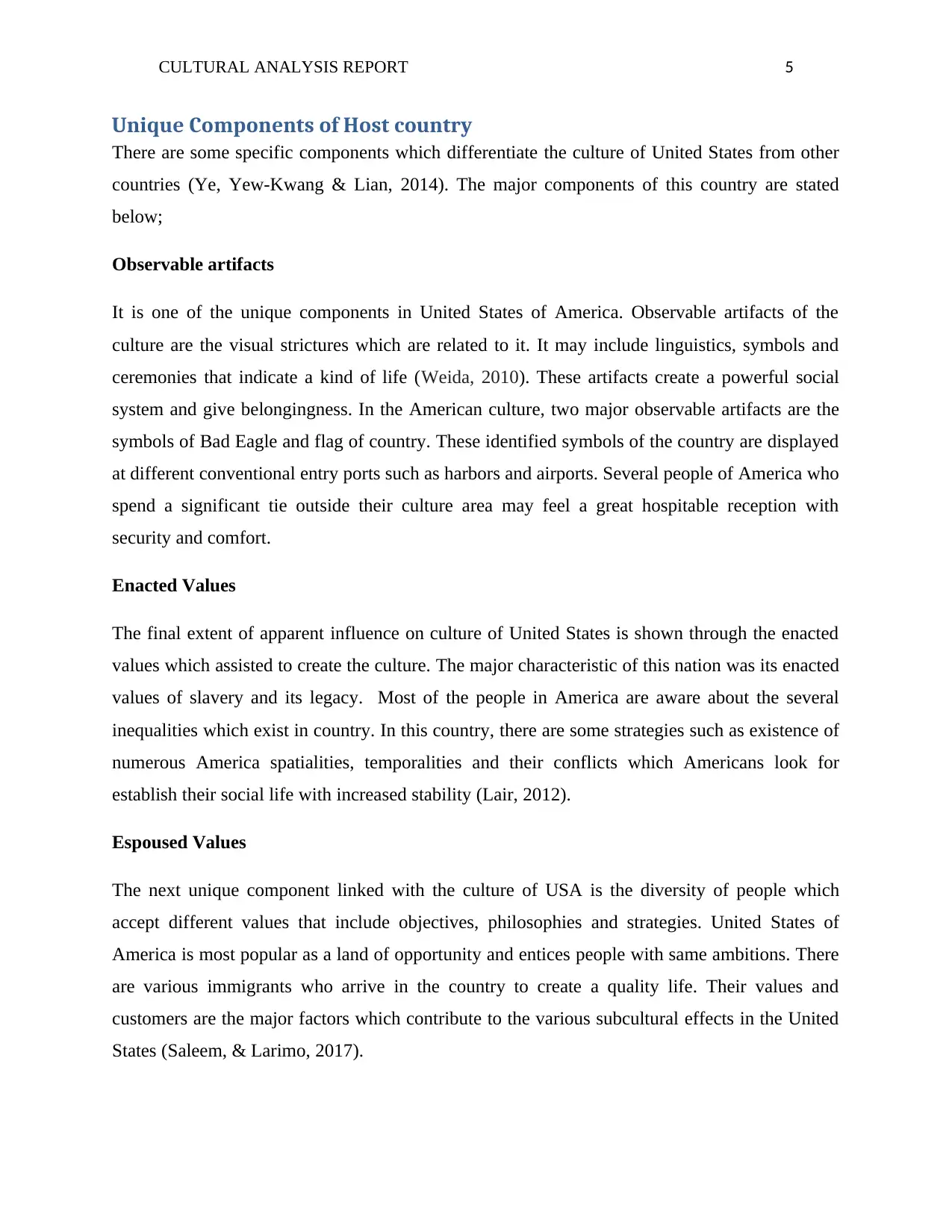
CULTURAL ANALYSIS REPORT 5
Unique Components of Host country
There are some specific components which differentiate the culture of United States from other
countries (Ye, Yew-Kwang & Lian, 2014). The major components of this country are stated
below;
Observable artifacts
It is one of the unique components in United States of America. Observable artifacts of the
culture are the visual strictures which are related to it. It may include linguistics, symbols and
ceremonies that indicate a kind of life (Weida, 2010). These artifacts create a powerful social
system and give belongingness. In the American culture, two major observable artifacts are the
symbols of Bad Eagle and flag of country. These identified symbols of the country are displayed
at different conventional entry ports such as harbors and airports. Several people of America who
spend a significant tie outside their culture area may feel a great hospitable reception with
security and comfort.
Enacted Values
The final extent of apparent influence on culture of United States is shown through the enacted
values which assisted to create the culture. The major characteristic of this nation was its enacted
values of slavery and its legacy. Most of the people in America are aware about the several
inequalities which exist in country. In this country, there are some strategies such as existence of
numerous America spatialities, temporalities and their conflicts which Americans look for
establish their social life with increased stability (Lair, 2012).
Espoused Values
The next unique component linked with the culture of USA is the diversity of people which
accept different values that include objectives, philosophies and strategies. United States of
America is most popular as a land of opportunity and entices people with same ambitions. There
are various immigrants who arrive in the country to create a quality life. Their values and
customers are the major factors which contribute to the various subcultural effects in the United
States (Saleem, & Larimo, 2017).
Unique Components of Host country
There are some specific components which differentiate the culture of United States from other
countries (Ye, Yew-Kwang & Lian, 2014). The major components of this country are stated
below;
Observable artifacts
It is one of the unique components in United States of America. Observable artifacts of the
culture are the visual strictures which are related to it. It may include linguistics, symbols and
ceremonies that indicate a kind of life (Weida, 2010). These artifacts create a powerful social
system and give belongingness. In the American culture, two major observable artifacts are the
symbols of Bad Eagle and flag of country. These identified symbols of the country are displayed
at different conventional entry ports such as harbors and airports. Several people of America who
spend a significant tie outside their culture area may feel a great hospitable reception with
security and comfort.
Enacted Values
The final extent of apparent influence on culture of United States is shown through the enacted
values which assisted to create the culture. The major characteristic of this nation was its enacted
values of slavery and its legacy. Most of the people in America are aware about the several
inequalities which exist in country. In this country, there are some strategies such as existence of
numerous America spatialities, temporalities and their conflicts which Americans look for
establish their social life with increased stability (Lair, 2012).
Espoused Values
The next unique component linked with the culture of USA is the diversity of people which
accept different values that include objectives, philosophies and strategies. United States of
America is most popular as a land of opportunity and entices people with same ambitions. There
are various immigrants who arrive in the country to create a quality life. Their values and
customers are the major factors which contribute to the various subcultural effects in the United
States (Saleem, & Larimo, 2017).
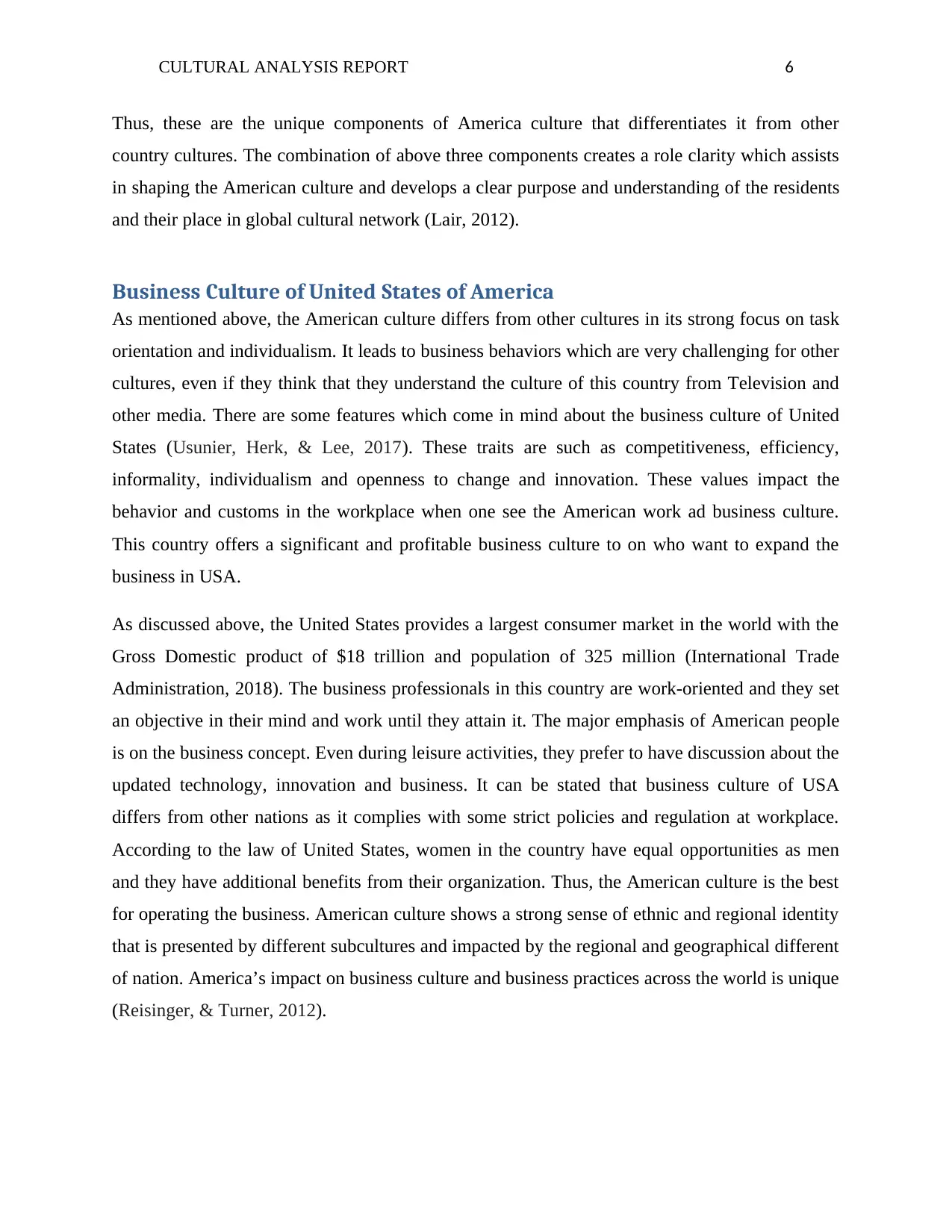
CULTURAL ANALYSIS REPORT 6
Thus, these are the unique components of America culture that differentiates it from other
country cultures. The combination of above three components creates a role clarity which assists
in shaping the American culture and develops a clear purpose and understanding of the residents
and their place in global cultural network (Lair, 2012).
Business Culture of United States of America
As mentioned above, the American culture differs from other cultures in its strong focus on task
orientation and individualism. It leads to business behaviors which are very challenging for other
cultures, even if they think that they understand the culture of this country from Television and
other media. There are some features which come in mind about the business culture of United
States (Usunier, Herk, & Lee, 2017). These traits are such as competitiveness, efficiency,
informality, individualism and openness to change and innovation. These values impact the
behavior and customs in the workplace when one see the American work ad business culture.
This country offers a significant and profitable business culture to on who want to expand the
business in USA.
As discussed above, the United States provides a largest consumer market in the world with the
Gross Domestic product of $18 trillion and population of 325 million (International Trade
Administration, 2018). The business professionals in this country are work-oriented and they set
an objective in their mind and work until they attain it. The major emphasis of American people
is on the business concept. Even during leisure activities, they prefer to have discussion about the
updated technology, innovation and business. It can be stated that business culture of USA
differs from other nations as it complies with some strict policies and regulation at workplace.
According to the law of United States, women in the country have equal opportunities as men
and they have additional benefits from their organization. Thus, the American culture is the best
for operating the business. American culture shows a strong sense of ethnic and regional identity
that is presented by different subcultures and impacted by the regional and geographical different
of nation. America’s impact on business culture and business practices across the world is unique
(Reisinger, & Turner, 2012).
Thus, these are the unique components of America culture that differentiates it from other
country cultures. The combination of above three components creates a role clarity which assists
in shaping the American culture and develops a clear purpose and understanding of the residents
and their place in global cultural network (Lair, 2012).
Business Culture of United States of America
As mentioned above, the American culture differs from other cultures in its strong focus on task
orientation and individualism. It leads to business behaviors which are very challenging for other
cultures, even if they think that they understand the culture of this country from Television and
other media. There are some features which come in mind about the business culture of United
States (Usunier, Herk, & Lee, 2017). These traits are such as competitiveness, efficiency,
informality, individualism and openness to change and innovation. These values impact the
behavior and customs in the workplace when one see the American work ad business culture.
This country offers a significant and profitable business culture to on who want to expand the
business in USA.
As discussed above, the United States provides a largest consumer market in the world with the
Gross Domestic product of $18 trillion and population of 325 million (International Trade
Administration, 2018). The business professionals in this country are work-oriented and they set
an objective in their mind and work until they attain it. The major emphasis of American people
is on the business concept. Even during leisure activities, they prefer to have discussion about the
updated technology, innovation and business. It can be stated that business culture of USA
differs from other nations as it complies with some strict policies and regulation at workplace.
According to the law of United States, women in the country have equal opportunities as men
and they have additional benefits from their organization. Thus, the American culture is the best
for operating the business. American culture shows a strong sense of ethnic and regional identity
that is presented by different subcultures and impacted by the regional and geographical different
of nation. America’s impact on business culture and business practices across the world is unique
(Reisinger, & Turner, 2012).
⊘ This is a preview!⊘
Do you want full access?
Subscribe today to unlock all pages.

Trusted by 1+ million students worldwide
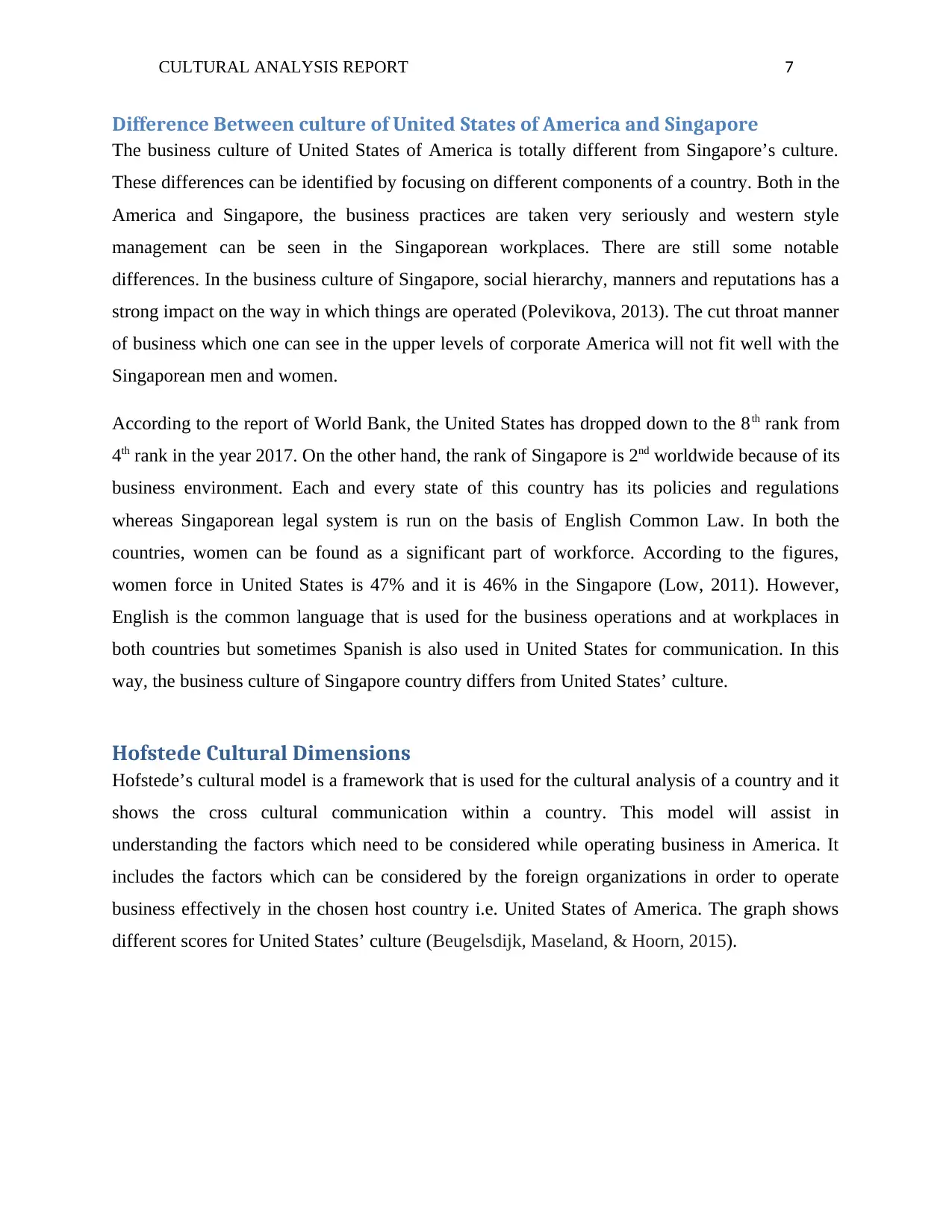
CULTURAL ANALYSIS REPORT 7
Difference Between culture of United States of America and Singapore
The business culture of United States of America is totally different from Singapore’s culture.
These differences can be identified by focusing on different components of a country. Both in the
America and Singapore, the business practices are taken very seriously and western style
management can be seen in the Singaporean workplaces. There are still some notable
differences. In the business culture of Singapore, social hierarchy, manners and reputations has a
strong impact on the way in which things are operated (Polevikova, 2013). The cut throat manner
of business which one can see in the upper levels of corporate America will not fit well with the
Singaporean men and women.
According to the report of World Bank, the United States has dropped down to the 8th rank from
4th rank in the year 2017. On the other hand, the rank of Singapore is 2nd worldwide because of its
business environment. Each and every state of this country has its policies and regulations
whereas Singaporean legal system is run on the basis of English Common Law. In both the
countries, women can be found as a significant part of workforce. According to the figures,
women force in United States is 47% and it is 46% in the Singapore (Low, 2011). However,
English is the common language that is used for the business operations and at workplaces in
both countries but sometimes Spanish is also used in United States for communication. In this
way, the business culture of Singapore country differs from United States’ culture.
Hofstede Cultural Dimensions
Hofstede’s cultural model is a framework that is used for the cultural analysis of a country and it
shows the cross cultural communication within a country. This model will assist in
understanding the factors which need to be considered while operating business in America. It
includes the factors which can be considered by the foreign organizations in order to operate
business effectively in the chosen host country i.e. United States of America. The graph shows
different scores for United States’ culture (Beugelsdijk, Maseland, & Hoorn, 2015).
Difference Between culture of United States of America and Singapore
The business culture of United States of America is totally different from Singapore’s culture.
These differences can be identified by focusing on different components of a country. Both in the
America and Singapore, the business practices are taken very seriously and western style
management can be seen in the Singaporean workplaces. There are still some notable
differences. In the business culture of Singapore, social hierarchy, manners and reputations has a
strong impact on the way in which things are operated (Polevikova, 2013). The cut throat manner
of business which one can see in the upper levels of corporate America will not fit well with the
Singaporean men and women.
According to the report of World Bank, the United States has dropped down to the 8th rank from
4th rank in the year 2017. On the other hand, the rank of Singapore is 2nd worldwide because of its
business environment. Each and every state of this country has its policies and regulations
whereas Singaporean legal system is run on the basis of English Common Law. In both the
countries, women can be found as a significant part of workforce. According to the figures,
women force in United States is 47% and it is 46% in the Singapore (Low, 2011). However,
English is the common language that is used for the business operations and at workplaces in
both countries but sometimes Spanish is also used in United States for communication. In this
way, the business culture of Singapore country differs from United States’ culture.
Hofstede Cultural Dimensions
Hofstede’s cultural model is a framework that is used for the cultural analysis of a country and it
shows the cross cultural communication within a country. This model will assist in
understanding the factors which need to be considered while operating business in America. It
includes the factors which can be considered by the foreign organizations in order to operate
business effectively in the chosen host country i.e. United States of America. The graph shows
different scores for United States’ culture (Beugelsdijk, Maseland, & Hoorn, 2015).
Paraphrase This Document
Need a fresh take? Get an instant paraphrase of this document with our AI Paraphraser
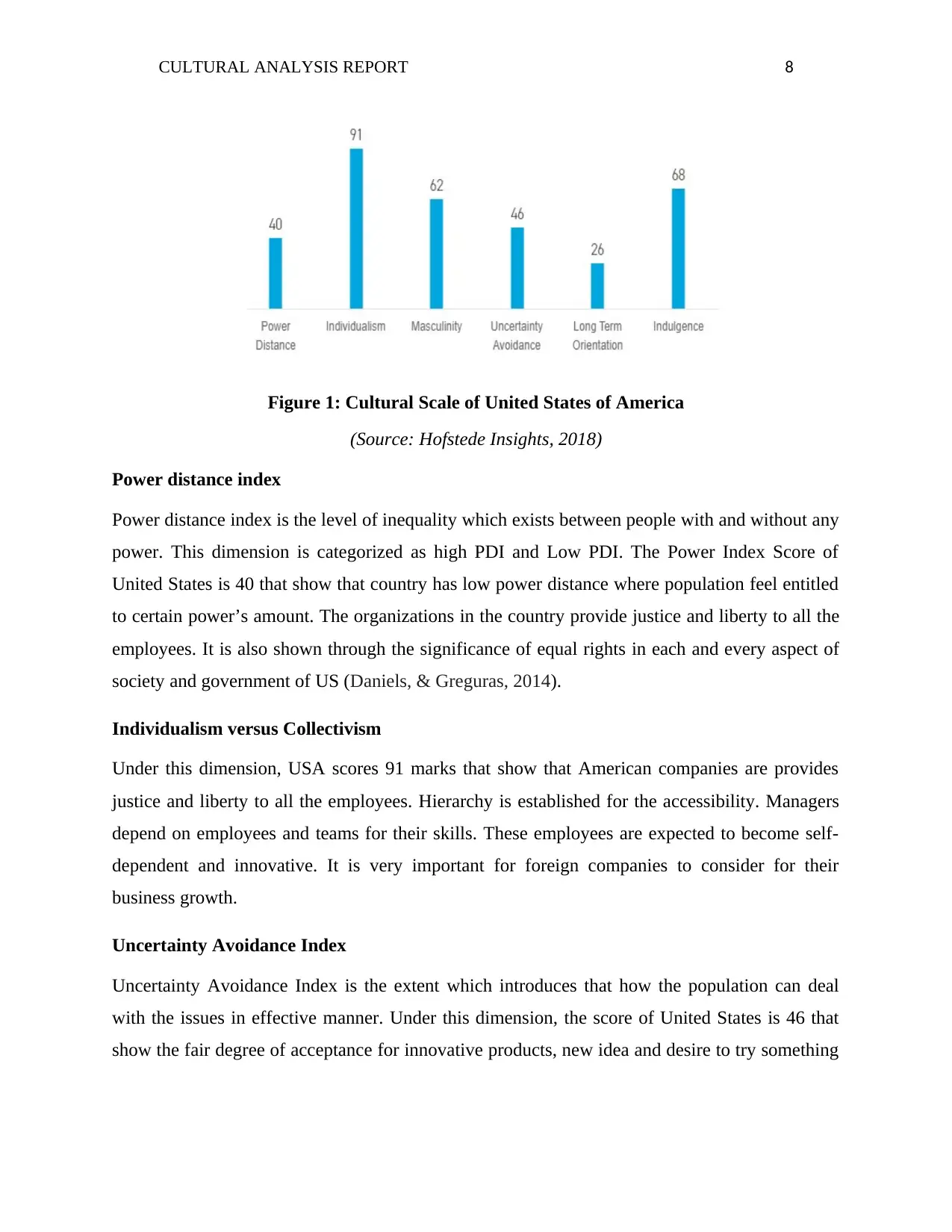
CULTURAL ANALYSIS REPORT 8
Figure 1: Cultural Scale of United States of America
(Source: Hofstede Insights, 2018)
Power distance index
Power distance index is the level of inequality which exists between people with and without any
power. This dimension is categorized as high PDI and Low PDI. The Power Index Score of
United States is 40 that show that country has low power distance where population feel entitled
to certain power’s amount. The organizations in the country provide justice and liberty to all the
employees. It is also shown through the significance of equal rights in each and every aspect of
society and government of US (Daniels, & Greguras, 2014).
Individualism versus Collectivism
Under this dimension, USA scores 91 marks that show that American companies are provides
justice and liberty to all the employees. Hierarchy is established for the accessibility. Managers
depend on employees and teams for their skills. These employees are expected to become self-
dependent and innovative. It is very important for foreign companies to consider for their
business growth.
Uncertainty Avoidance Index
Uncertainty Avoidance Index is the extent which introduces that how the population can deal
with the issues in effective manner. Under this dimension, the score of United States is 46 that
show the fair degree of acceptance for innovative products, new idea and desire to try something
Figure 1: Cultural Scale of United States of America
(Source: Hofstede Insights, 2018)
Power distance index
Power distance index is the level of inequality which exists between people with and without any
power. This dimension is categorized as high PDI and Low PDI. The Power Index Score of
United States is 40 that show that country has low power distance where population feel entitled
to certain power’s amount. The organizations in the country provide justice and liberty to all the
employees. It is also shown through the significance of equal rights in each and every aspect of
society and government of US (Daniels, & Greguras, 2014).
Individualism versus Collectivism
Under this dimension, USA scores 91 marks that show that American companies are provides
justice and liberty to all the employees. Hierarchy is established for the accessibility. Managers
depend on employees and teams for their skills. These employees are expected to become self-
dependent and innovative. It is very important for foreign companies to consider for their
business growth.
Uncertainty Avoidance Index
Uncertainty Avoidance Index is the extent which introduces that how the population can deal
with the issues in effective manner. Under this dimension, the score of United States is 46 that
show the fair degree of acceptance for innovative products, new idea and desire to try something
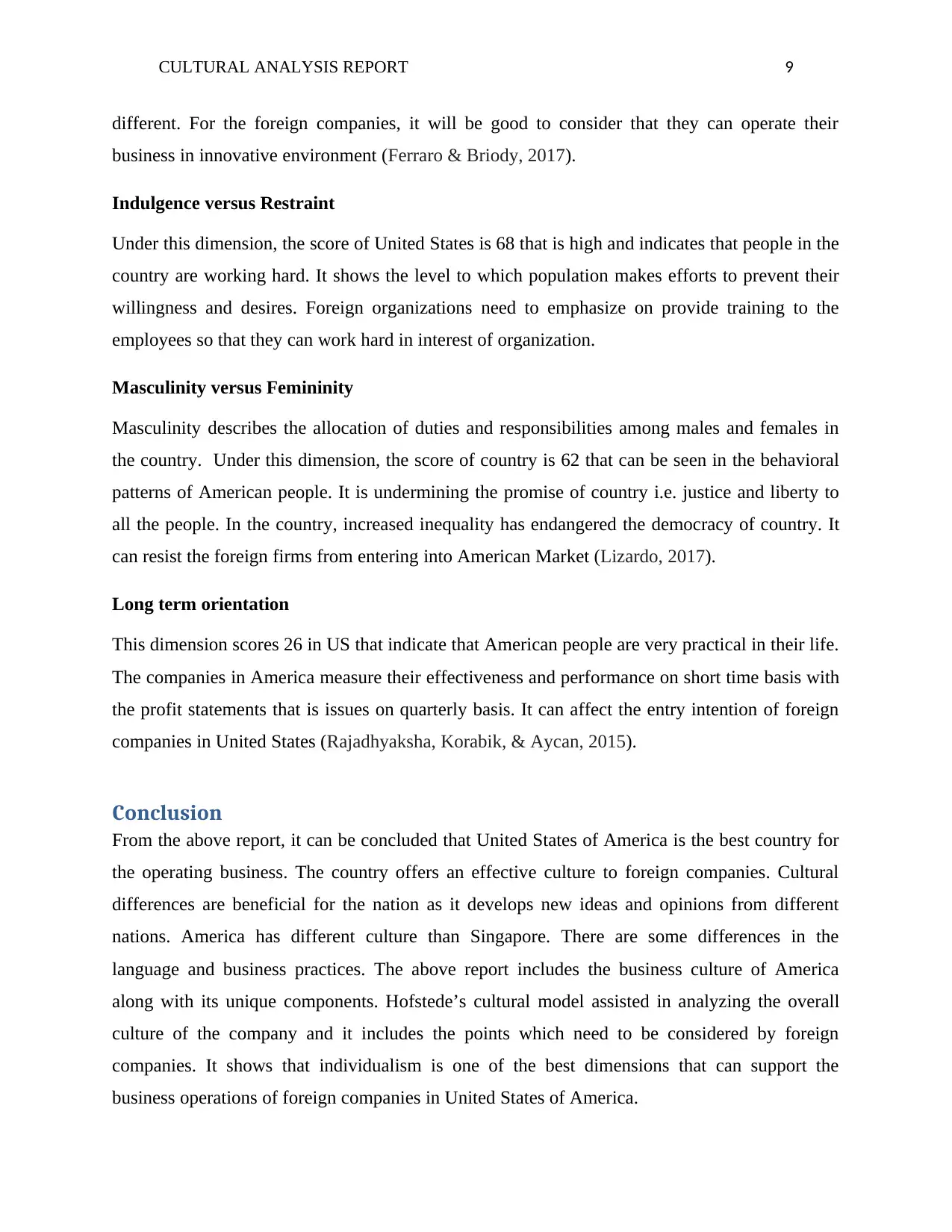
CULTURAL ANALYSIS REPORT 9
different. For the foreign companies, it will be good to consider that they can operate their
business in innovative environment (Ferraro & Briody, 2017).
Indulgence versus Restraint
Under this dimension, the score of United States is 68 that is high and indicates that people in the
country are working hard. It shows the level to which population makes efforts to prevent their
willingness and desires. Foreign organizations need to emphasize on provide training to the
employees so that they can work hard in interest of organization.
Masculinity versus Femininity
Masculinity describes the allocation of duties and responsibilities among males and females in
the country. Under this dimension, the score of country is 62 that can be seen in the behavioral
patterns of American people. It is undermining the promise of country i.e. justice and liberty to
all the people. In the country, increased inequality has endangered the democracy of country. It
can resist the foreign firms from entering into American Market (Lizardo, 2017).
Long term orientation
This dimension scores 26 in US that indicate that American people are very practical in their life.
The companies in America measure their effectiveness and performance on short time basis with
the profit statements that is issues on quarterly basis. It can affect the entry intention of foreign
companies in United States (Rajadhyaksha, Korabik, & Aycan, 2015).
Conclusion
From the above report, it can be concluded that United States of America is the best country for
the operating business. The country offers an effective culture to foreign companies. Cultural
differences are beneficial for the nation as it develops new ideas and opinions from different
nations. America has different culture than Singapore. There are some differences in the
language and business practices. The above report includes the business culture of America
along with its unique components. Hofstede’s cultural model assisted in analyzing the overall
culture of the company and it includes the points which need to be considered by foreign
companies. It shows that individualism is one of the best dimensions that can support the
business operations of foreign companies in United States of America.
different. For the foreign companies, it will be good to consider that they can operate their
business in innovative environment (Ferraro & Briody, 2017).
Indulgence versus Restraint
Under this dimension, the score of United States is 68 that is high and indicates that people in the
country are working hard. It shows the level to which population makes efforts to prevent their
willingness and desires. Foreign organizations need to emphasize on provide training to the
employees so that they can work hard in interest of organization.
Masculinity versus Femininity
Masculinity describes the allocation of duties and responsibilities among males and females in
the country. Under this dimension, the score of country is 62 that can be seen in the behavioral
patterns of American people. It is undermining the promise of country i.e. justice and liberty to
all the people. In the country, increased inequality has endangered the democracy of country. It
can resist the foreign firms from entering into American Market (Lizardo, 2017).
Long term orientation
This dimension scores 26 in US that indicate that American people are very practical in their life.
The companies in America measure their effectiveness and performance on short time basis with
the profit statements that is issues on quarterly basis. It can affect the entry intention of foreign
companies in United States (Rajadhyaksha, Korabik, & Aycan, 2015).
Conclusion
From the above report, it can be concluded that United States of America is the best country for
the operating business. The country offers an effective culture to foreign companies. Cultural
differences are beneficial for the nation as it develops new ideas and opinions from different
nations. America has different culture than Singapore. There are some differences in the
language and business practices. The above report includes the business culture of America
along with its unique components. Hofstede’s cultural model assisted in analyzing the overall
culture of the company and it includes the points which need to be considered by foreign
companies. It shows that individualism is one of the best dimensions that can support the
business operations of foreign companies in United States of America.
⊘ This is a preview!⊘
Do you want full access?
Subscribe today to unlock all pages.

Trusted by 1+ million students worldwide
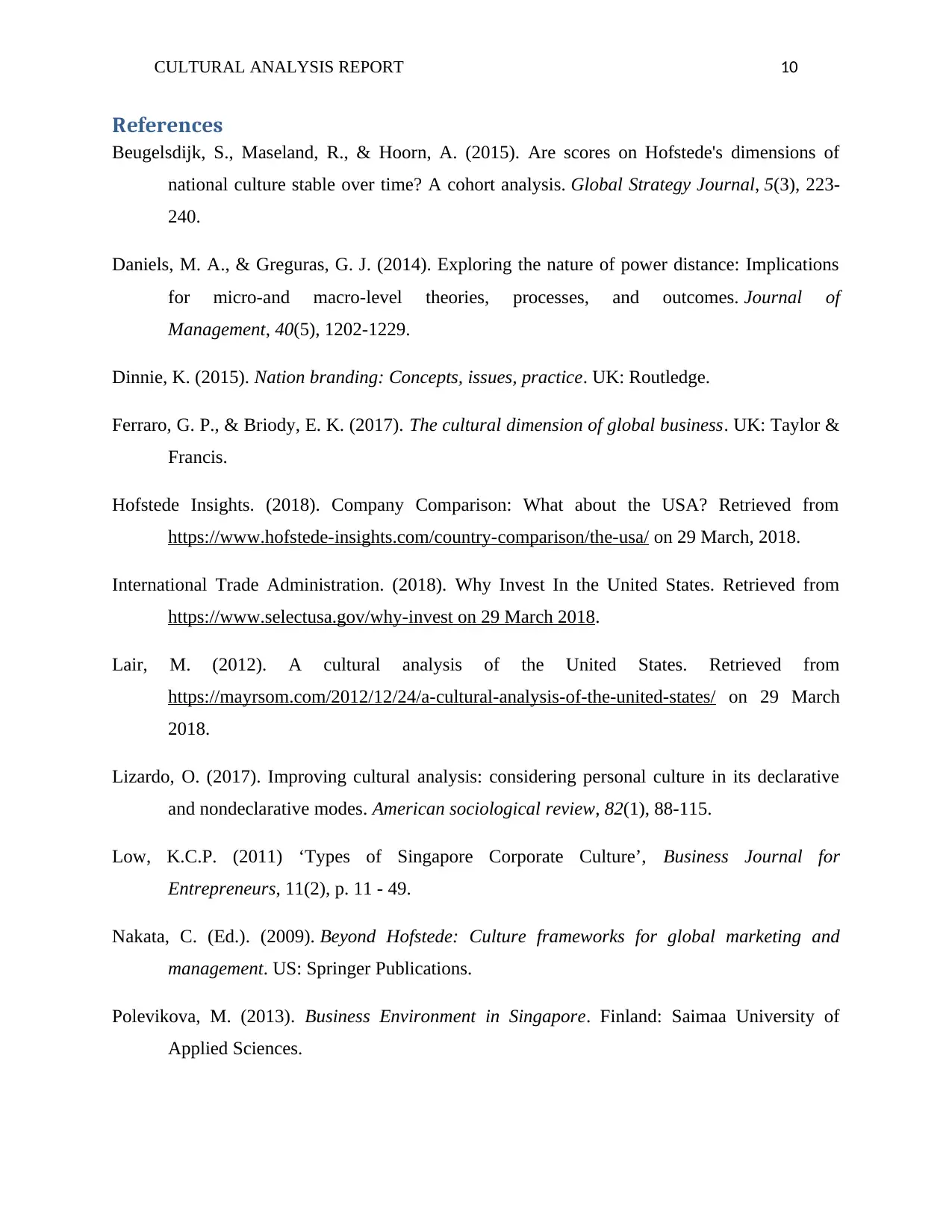
CULTURAL ANALYSIS REPORT 10
References
Beugelsdijk, S., Maseland, R., & Hoorn, A. (2015). Are scores on Hofstede's dimensions of
national culture stable over time? A cohort analysis. Global Strategy Journal, 5(3), 223-
240.
Daniels, M. A., & Greguras, G. J. (2014). Exploring the nature of power distance: Implications
for micro-and macro-level theories, processes, and outcomes. Journal of
Management, 40(5), 1202-1229.
Dinnie, K. (2015). Nation branding: Concepts, issues, practice. UK: Routledge.
Ferraro, G. P., & Briody, E. K. (2017). The cultural dimension of global business. UK: Taylor &
Francis.
Hofstede Insights. (2018). Company Comparison: What about the USA? Retrieved from
https://www.hofstede-insights.com/country-comparison/the-usa/ on 29 March, 2018.
International Trade Administration. (2018). Why Invest In the United States. Retrieved from
https://www.selectusa.gov/why-invest on 29 March 2018.
Lair, M. (2012). A cultural analysis of the United States. Retrieved from
https://mayrsom.com/2012/12/24/a-cultural-analysis-of-the-united-states/ on 29 March
2018.
Lizardo, O. (2017). Improving cultural analysis: considering personal culture in its declarative
and nondeclarative modes. American sociological review, 82(1), 88-115.
Low, K.C.P. (2011) ‘Types of Singapore Corporate Culture’, Business Journal for
Entrepreneurs, 11(2), p. 11 - 49.
Nakata, C. (Ed.). (2009). Beyond Hofstede: Culture frameworks for global marketing and
management. US: Springer Publications.
Polevikova, M. (2013). Business Environment in Singapore. Finland: Saimaa University of
Applied Sciences.
References
Beugelsdijk, S., Maseland, R., & Hoorn, A. (2015). Are scores on Hofstede's dimensions of
national culture stable over time? A cohort analysis. Global Strategy Journal, 5(3), 223-
240.
Daniels, M. A., & Greguras, G. J. (2014). Exploring the nature of power distance: Implications
for micro-and macro-level theories, processes, and outcomes. Journal of
Management, 40(5), 1202-1229.
Dinnie, K. (2015). Nation branding: Concepts, issues, practice. UK: Routledge.
Ferraro, G. P., & Briody, E. K. (2017). The cultural dimension of global business. UK: Taylor &
Francis.
Hofstede Insights. (2018). Company Comparison: What about the USA? Retrieved from
https://www.hofstede-insights.com/country-comparison/the-usa/ on 29 March, 2018.
International Trade Administration. (2018). Why Invest In the United States. Retrieved from
https://www.selectusa.gov/why-invest on 29 March 2018.
Lair, M. (2012). A cultural analysis of the United States. Retrieved from
https://mayrsom.com/2012/12/24/a-cultural-analysis-of-the-united-states/ on 29 March
2018.
Lizardo, O. (2017). Improving cultural analysis: considering personal culture in its declarative
and nondeclarative modes. American sociological review, 82(1), 88-115.
Low, K.C.P. (2011) ‘Types of Singapore Corporate Culture’, Business Journal for
Entrepreneurs, 11(2), p. 11 - 49.
Nakata, C. (Ed.). (2009). Beyond Hofstede: Culture frameworks for global marketing and
management. US: Springer Publications.
Polevikova, M. (2013). Business Environment in Singapore. Finland: Saimaa University of
Applied Sciences.
Paraphrase This Document
Need a fresh take? Get an instant paraphrase of this document with our AI Paraphraser
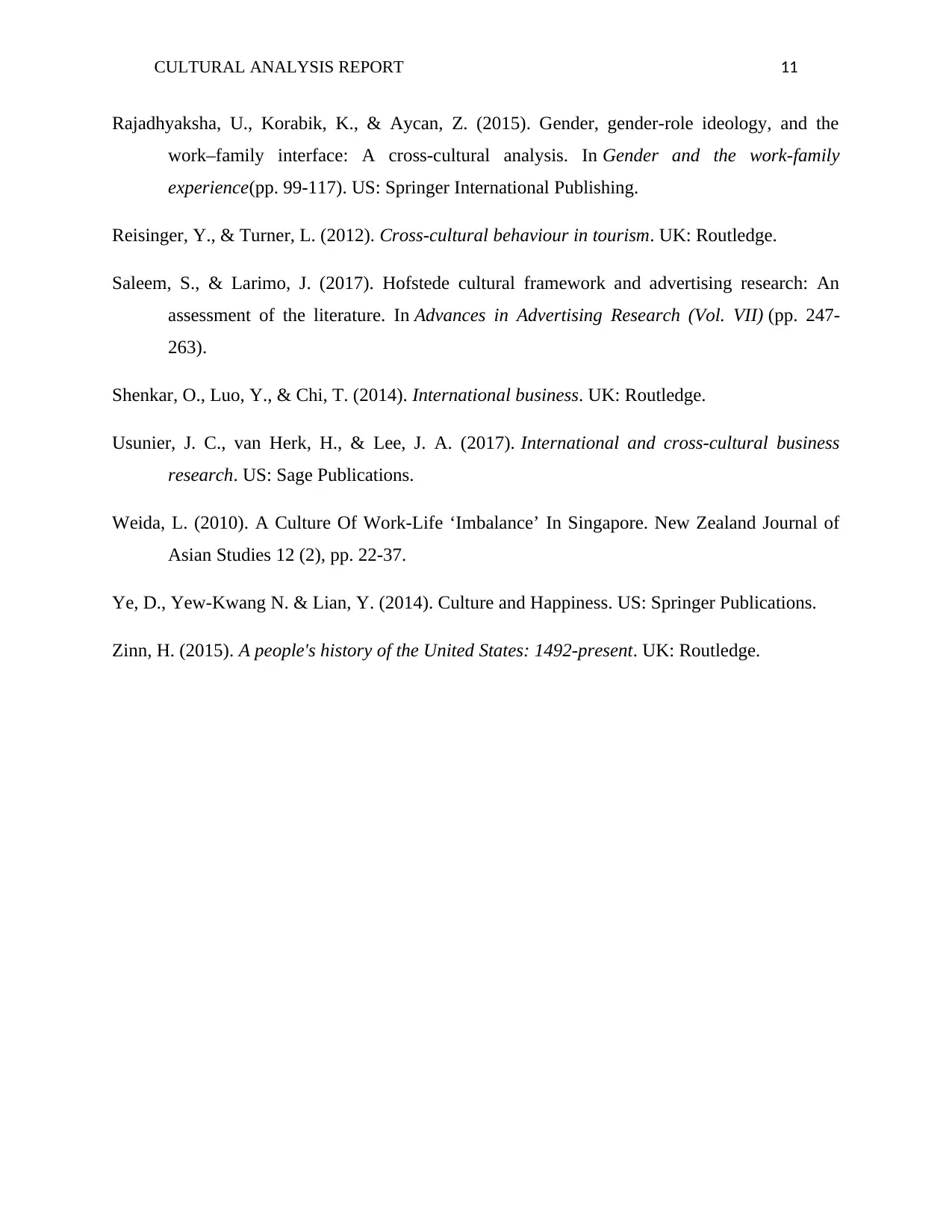
CULTURAL ANALYSIS REPORT 11
Rajadhyaksha, U., Korabik, K., & Aycan, Z. (2015). Gender, gender-role ideology, and the
work–family interface: A cross-cultural analysis. In Gender and the work-family
experience(pp. 99-117). US: Springer International Publishing.
Reisinger, Y., & Turner, L. (2012). Cross-cultural behaviour in tourism. UK: Routledge.
Saleem, S., & Larimo, J. (2017). Hofstede cultural framework and advertising research: An
assessment of the literature. In Advances in Advertising Research (Vol. VII) (pp. 247-
263).
Shenkar, O., Luo, Y., & Chi, T. (2014). International business. UK: Routledge.
Usunier, J. C., van Herk, H., & Lee, J. A. (2017). International and cross-cultural business
research. US: Sage Publications.
Weida, L. (2010). A Culture Of Work-Life ‘Imbalance’ In Singapore. New Zealand Journal of
Asian Studies 12 (2), pp. 22-37.
Ye, D., Yew-Kwang N. & Lian, Y. (2014). Culture and Happiness. US: Springer Publications.
Zinn, H. (2015). A people's history of the United States: 1492-present. UK: Routledge.
Rajadhyaksha, U., Korabik, K., & Aycan, Z. (2015). Gender, gender-role ideology, and the
work–family interface: A cross-cultural analysis. In Gender and the work-family
experience(pp. 99-117). US: Springer International Publishing.
Reisinger, Y., & Turner, L. (2012). Cross-cultural behaviour in tourism. UK: Routledge.
Saleem, S., & Larimo, J. (2017). Hofstede cultural framework and advertising research: An
assessment of the literature. In Advances in Advertising Research (Vol. VII) (pp. 247-
263).
Shenkar, O., Luo, Y., & Chi, T. (2014). International business. UK: Routledge.
Usunier, J. C., van Herk, H., & Lee, J. A. (2017). International and cross-cultural business
research. US: Sage Publications.
Weida, L. (2010). A Culture Of Work-Life ‘Imbalance’ In Singapore. New Zealand Journal of
Asian Studies 12 (2), pp. 22-37.
Ye, D., Yew-Kwang N. & Lian, Y. (2014). Culture and Happiness. US: Springer Publications.
Zinn, H. (2015). A people's history of the United States: 1492-present. UK: Routledge.

CULTURAL ANALYSIS REPORT 12
⊘ This is a preview!⊘
Do you want full access?
Subscribe today to unlock all pages.

Trusted by 1+ million students worldwide
1 out of 13
Related Documents
Your All-in-One AI-Powered Toolkit for Academic Success.
+13062052269
info@desklib.com
Available 24*7 on WhatsApp / Email
![[object Object]](/_next/static/media/star-bottom.7253800d.svg)
Unlock your academic potential
Copyright © 2020–2025 A2Z Services. All Rights Reserved. Developed and managed by ZUCOL.





